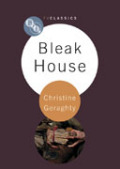
Bleak House.is one of Charles Dickens' darker books, brilliantly constructed around the extended legal case which enmeshes its characters and a vision of London as the polluted centre of an industrialising nation. It was, like other Dickens' works a highly successful serial and, along with Wilkie Collins' The Moonstone, was one of the first successful detective stories. Writing in the mid-nineteenth century, Dickens was the first media personality whose working practices compare with those of contemporary television. In publicising its 2005 adaptation, the BBC announced 'Bleak House gets the soap opera treatment' but the serial was also used to demonstrate the BBC's commitment to high qualitydrama. Shot in HD, produced by double-BAFTA winner Nigel Stafford-Clark, and starring Gillian Anderson, the production aimed to combine soap opera suspense, visual innovation and outstanding performances in an appeal to youthful audiences. Starting by looking at how serialization works for Dickens and in contemporary soap opera, this book shows how the BBC sold the programme as a soap, going on to look at its status as a British classic serial, with the traditional expectations of a high cost co-production, strong on acting and period detail. Geraghty examines the way the serial was discussed by the production team and the press, including the controversies about the missing fog and the notorious visual effects. And she takes issue with adaptor Andrew Davies for his attitude to Dickens's most complex heroine Esther Summerson, played by rising star, Anna Maxwell Martin. In a fascinating exploration of the serial, which played over eight hours in fifteen episodes, Geraghty teases out the double narrative in which the youthful protagonists grow into adulthood while the doomed Lady Dedlock is hunted to death in a tele-noir adaptation of the British novel's first detective story. She looks at the innovative casting and examines how the different styles of acting relate to Dickens's own vivid characterisation.She also explores the settings including the creation of London, styled as a soap-opera set, and the great country houses where secrets are kept under wrap. And, using illustrations from the novel, she looks at how the traditional Dickensian 'picture' combined with HD visuals for the first time in a classic serial. Bleak House was a successful example of the BBC's global brand and a controversial fulfilment of its public service responsibilities. Geraghty makes acritical case for Bleak House to become a TV Classic. INDICE: Acknowledgments. Introduction: Dickens and Television.The Classic Serial. Serialisation and Soaps. The Problem with Esther. Narrative Organisation and the Double Story. Characterisation and Performance. Settings. 'Illustrating' Bleak House. Conclusion: Classic Television. Notes. Appendix: The Beginning and Ending of Each Episode. Bibliography. Credits. Index
- ISBN: 978-1-84457-417-9
- Editorial: British Film Institute
- Encuadernacion: Rústica
- Páginas: 152
- Fecha Publicación: 28/09/2012
- Nº Volúmenes: 1
- Idioma: Desconocido
